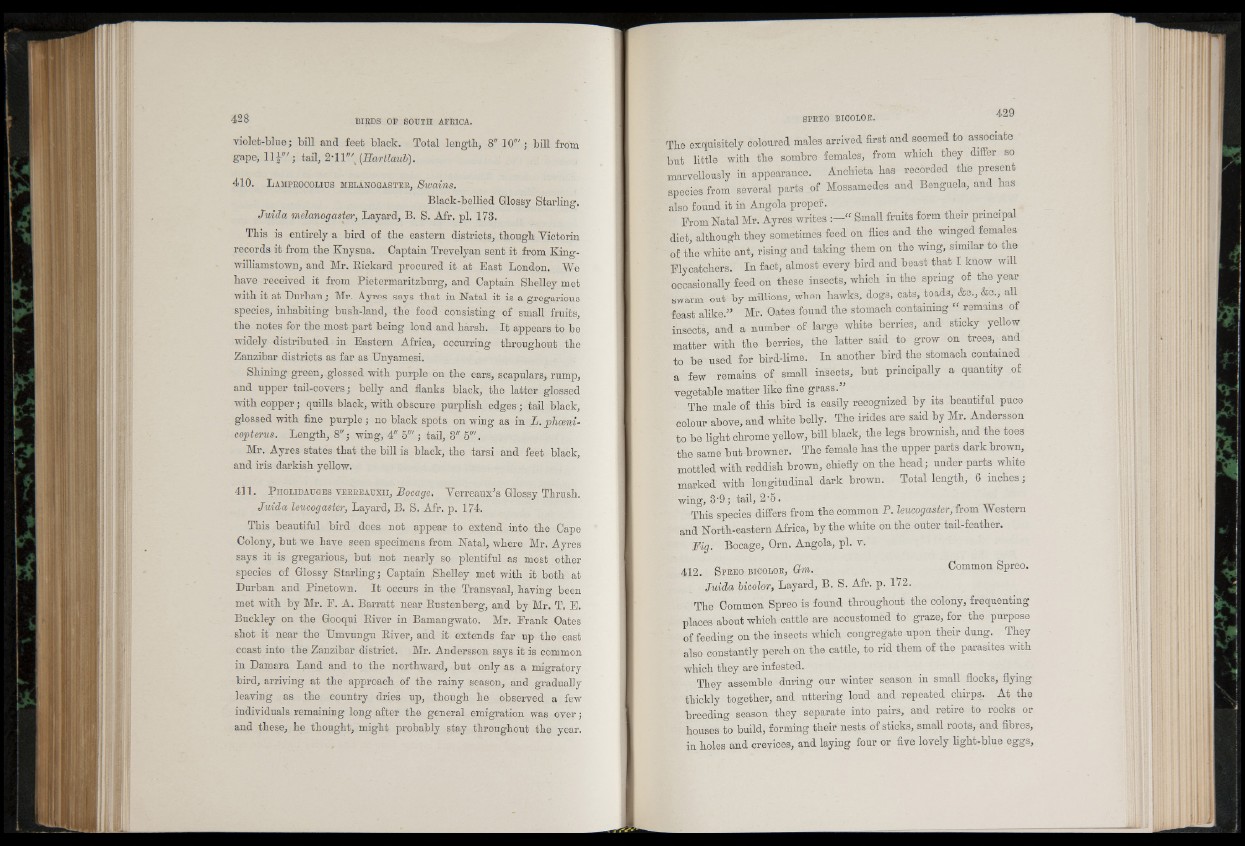
violet-blue; bill and feet black. Total length, 8" 10"'; bill from
gape, 11 j." $ tail, 211 "\(Eartlaub).
410. L amprocolius h ela n og a st er, Swains.
Black-bellied Glossy Starling.
Juida melanogaster, Layard, B. S. Afr. pi. 173.
This is entirely a bird of the eastern districts, though Victorin
records it from the Knysna. Captain Trevelyan sent it from King-
williamstown, and Mr. Rickard procured it at Bast London. We
hare received it from Pietermaritzburg, and Captain Shelley met
■with it at Durban; Mr. Ayres says that in Natal it is a gregarious
species, inhabiting bush-land, the food consisting of small fruits,
the notes for the most part being loud and harsh. It appears to be
widely distributed in Eastern Africa, occurring throughout the
Zanzibar districts as far as Unyamesi.
Shining green, glossed with purple on the ears, scapulars, rump,
and upper tail-covers; belly and flanks black, the latter glossed
with copper; quills black, with obscure purplish edges; tail black,
glossed with fine purple; no black spots on wing as in L. phoeni-
copterus. Length, 8"; wing, 4" 6'" ; tail, 3" 5'".
Mr. Ayres states that the bill is black, the tarsi and feet black,
and iris darkish yellow.
411. P hol idauge s v er e ea u x ii, Bocage. Yerreaux’s Glossy Thrush.
Juida leucogaster, Layard, B. S. Afr. p. 174.
This beautiful bird does not appear to extend into the Cape
Colony, but we have seen specimens from Natal, where Mr. Ayres
says it is gregarious, but not nearly so plentiful as most other
species of Glossy Starling; Captain .Shelley met with it both at
Durban and Pinetown. It occurs in the Transvaal, having been
met with by Mr. F. A. Barratt near Rustenberg, and by Mr. T. E.
Buckley on the Gooqui River in Bamangwato. Mr. Frank Oates
shot it near the Umvungu River, and it extends far up the east
coast into the Zanzibar district. Mr. Andersson says it is common
in Damara Land and to the northward, but only as a migratory
bird, arriving at the approach of the rainy season, and gradually
leaving as the country dries up, though he observed a few
individuals remaining long after the general emigration was over;
and these, he thought, might probably stay throughout the year.
The exquisitely coloured males arrived first and seemed to associate
but little with the sombre females, from which they differ so
marvellously in appearance. Anchieta has recorded the present
species from several parts of Mossamedes and Benguela, and has
also found it in Angola proper. .
From Natal Mr. Ayres writes Small fruits form their principal
diet although they sometimes feed on flies and the winged females
of the white ant, rising and taking them on the wing, similar to the
Flycatchers. In fact, almost every bird and beast that I know will
occasionally feed on these insects, which in the spring of the year
swarm out by millions, when hawks, dog3, cats, toads, &c., &e., all
feast alike.” Mr. Oates found the stomach containing “ remains of
insects, and a number of large white berries, and sticky yellow
matter with the berries, the latter said to grow on trees, and
to be used for bird-lime. In another bird the stomach contained ,
a few remains of small insects, but principally a quantity of
vegetable matter like fine grass.”
The male of this bird is easily recognized by its beautiful puce
colour above, and white belly. The irides are said by Mr. Andersson
to be light chrome yellow, bill black, the legs brownish, and the toes
the same but browner. The female has the upper parts dark brown,
mottled with reddish brown, chiefly on the head; under parts white
marked with longitudinal dark brown. Total length, 6 inches;
wing, 3 '9 ; tail, 2 ‘5 .
This species differs from the common P. leucog aster, from Western
and North-eastern Africa, by the white on the outer tail-feather.
Fig. Bocage, Orn. Angola, pi. v.
4 1 2 . S pr eo bioolor, Gm. Common Spreo.
Juida bicolor, Layard, B. S. Afr. p. 1 7 2 .
The Common Spreo is found throughout the colony, frequenting
places about which cattle are accustomed to graze, for the purpose
of feeding on the insects which congregate upon their dung. They
also constantly perch on the cattle, to rid them of the parasites with
which they are infested.
They assemble during our winter season in small flocks, flying
thickly together, and uttering loud and repeated chirps. At the
breeding season they separate into pairs, and retire to rocks or
houses to build, forming their nests of sticks, small roots, and fibres,
in holes and crevices, and laying four or five lovely light-blue eggs,